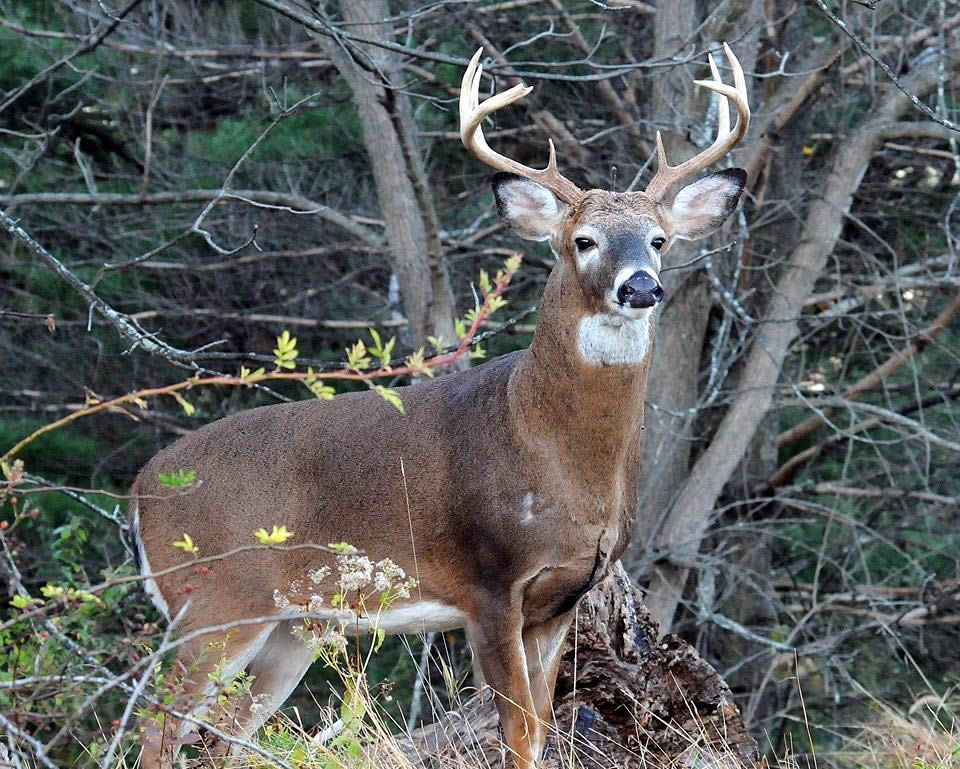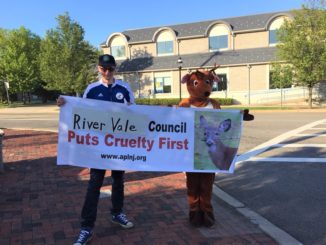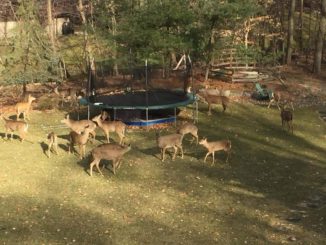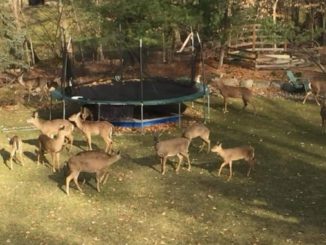
BY MICHAEL OLOHAN
OF PASCACK PRESS
RIVER VALE, N.J.—No one was on the fence when it came to talking deer control at a recent township Zoning Board hearing.
While fences may make good neighbors, a River Vale couple heard that they may not be the most popular or effective deer deterrent in a community crowded with white-tailed does and bucks when they appeared Dec. 20 before the Zoning Board of Adjustment.
The Colonial Road homeowners appeared with a landscape designer to request a variance for a mostly transparent 6-foot-high black vinyl-coated wire deer fence that would extend around the entire property.
A variance was needed to put the fence in the front yard as zoning code only allows fences no higher than three feet, which must be 50 percent open and unobstructed. A split-rail fence is given as one example meeting local code.
After more than an hour of back-and-forth discussion on possible plantings, fence heights, local deer problems and options to deter deer, most Zoning Board members appeared to be opposed to the 6-foot-high fence.
The applicants decided to withdraw their application and submit an amended application for review at the March 20, 2019, 7:30 p.m. meeting.
6-foot fence ineffective
Several times, Mayor Glen Jasionowski, a Planning Board member, stressed that approving a six-foot high deer fence for the corner property would not be effective in preventing deer from entering it and would likely lead to an influx of deer fence requests from property owners fed up with deer damage and droppings.
“From a mayor and council perspective, we hear deer complaints every time we show up. I get hundreds of emails, people who have spent tens of thousands on plantings and if you approve this application we will have 500 applications for the same thing. Just be aware of that,” said Jasionowski.
Jasionowski said state Fish and Wildlife officials told him that a deer fence needed to be at least 10-foot-high to be effective, but township zoning code only allows a maximum fence height of six feet.
The River Vale Council recently heard from Fish and Wildlife officials ahead of wildlife advocates as it mulls town deer-control measures, including authorizing a controlled hunt, which will be debated at upcoming proceedings.
Other members questioned whether plantings around the proposed deer fence would actually deter deer from jumping the fence.
Blythe Yost, of Yost Design Landscape Architecture, Pearl River, N.Y., said plantings even around 4-foot-high fences have been shown to be effective in reducing deer access to property.
She stressed that the proposed six-foot-high deer fence was “mostly transparent” as it was a mesh wire fence with 4 inch by 4 inch openings, with black vinyl coating the wire.
Yost said that approximately 10 pine trees line the front yard and with deer-resistant plantings behind the trees would help further deter deer from jumping the fence. She said the proposed fence would be about 10 feet from the curb, behind the tree line.
Member John Donovan said he was “not offended” by the proposed deer fence because it appeared to be well-hidden behind pine trees, plantings, and was mostly “invisible” due to its open wire mesh construction.
Jasionowski repeatedly wondered what was to be gained by approving a six-foot-high deer fence.
“What exponential benefit do you get from a 6-foot-high versus 4-foot fence?” he asked Yost.
She said two feet higher makes “a significant difference” but Jasionowski disagreed.
“Listen, the biggest problem the town faces right now: Everybody has a deer problem, everybody has deer feces in town and way too many people have Lyme disease. I’m trying to fix the problem,” he said. “If I let you, I need to let everyone in town do it,” the mayor said.
Member Susan Vaccaro said she believed the deer fence “would create an eyesore…and sets a precedent.”
She wondered about deer possibly getting trapped on a fenced-in property and doing damage, though the applicant assured her if he was not home someone would be watching the property.
Several residents spoke against the proposed fence variance, calling the fence an eyesore, a bad precedent and one charged it might lead to “a Berlin Wall” along Winding Way.
One of the applicants told members he spent “a significant amount of money” on plantings previously and promised that the fence would not be an “eyesore” and that he would spend additional funds on the deer fence and surrounding landscape plantings.
“Between the deer droppings and the ticks I’ve had it. After 16 years [here], this is the first time I’m asking for something,” he said.
Another applicant said she hoped that members would review their deer fence variance request on a case by case basis, as member John Donovan suggested, and not to the township-wide deer control issue.
She said their deer fence plan included a “planting plan that will camouflage the fence and not be an eyesore.”
Yost asked for a continuation until March 20 where the applicant’s amended proposal may include more details on landscape plantings or possibly a lower fence with specific plantings to deter deer from entering the property.



